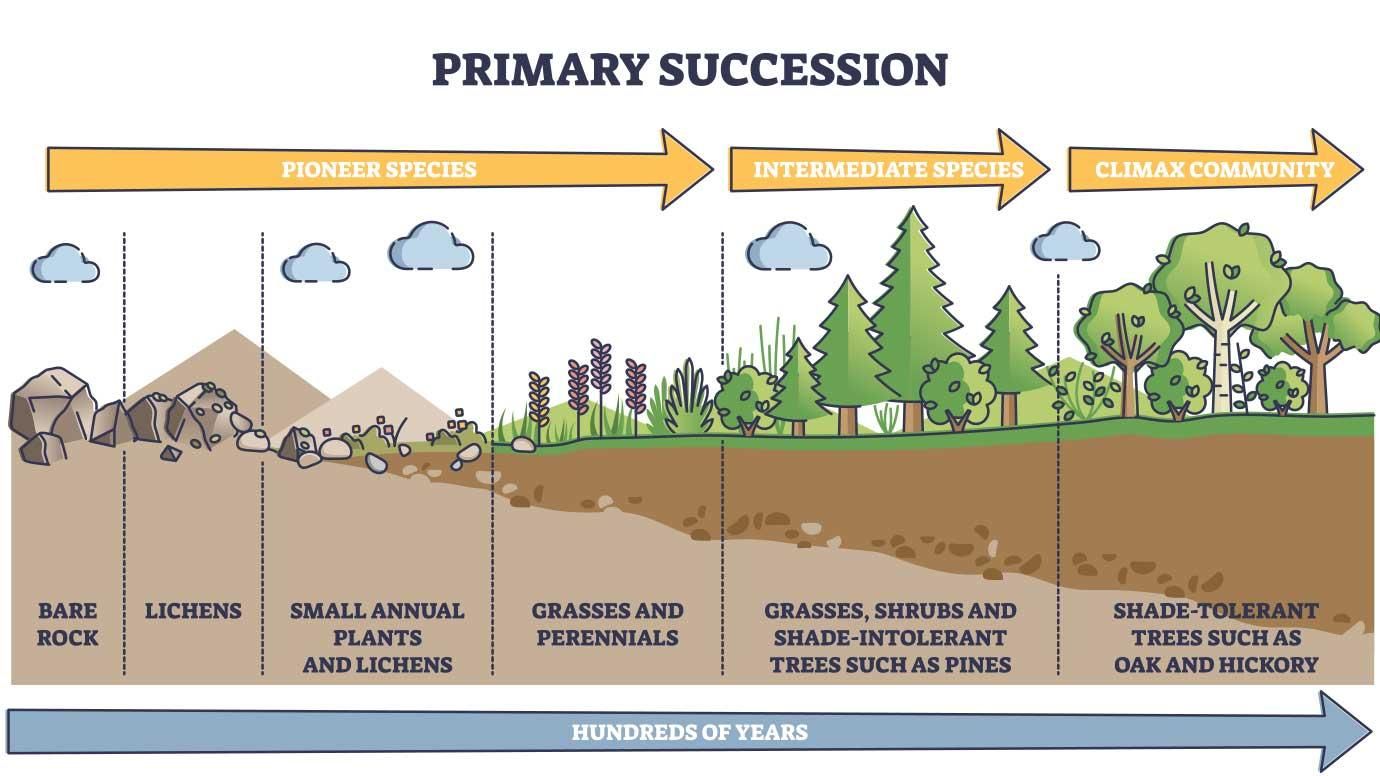Succession
Succession is the gradual process of change in ecosystems, where one community replaces another due to shifts in biotic and abiotic conditions.
- Succession is the process by which ecosystems develop and change over time, transforming from a simple community with few species to a complex, stable ecosystem with high biodiversity and intricate trophic relationships.
- It represents the temporal (time-based) change in an ecosystem’s structure and species composition, unlike zonation, which describes spatial changes along an environmental gradient.
- Succession is a key ecological process that demonstrates how biotic (living) and abiotic (non-living) factors interact to shape the dynamic nature of ecosystems.
Zonation is a spatial phenomenon, succession is a temporal phenomenon.
Stages of Succession (Seral Stage)
Seral community
A seral community (sere) is a stage in the process of succession, where one community modifies the environment, making it more suitable for the next community.
- Each stage of succession is called a seral stage or sere, representing a distinct community that modifies the environment, paving the way for the next stage.
- The community that occupies it is a seral community.
1. Pioneer Stage
- The first colonizers are hardy species like lichens, mosses, and algae.
- They tolerate harsh conditions (temperature extremes, desiccation, lack of nutrients).
- These species weather rocks and add organic matter when they die, forming the first thin layer of soil.
Lichens on volcanic rock produce weak acids that chemically weather rock surfaces, forming the first soil particles.
2. Intermediate Stage
- As soil forms, small plants and grasses establish, increasing nutrient cycling and water retention.
- Roots stabilize the soil and microorganisms enrich it with nitrogen and organic matter.
- Over time, shrubs and small trees replace grasses due to competitive advantages like taller growth and deeper roots.
3. Climax Stage
Climax community
A climax community is the final, stable community in succession, in equilibrium with its environment and characterized by high biodiversity, complex food webs, and efficient nutrient cycling.
- The final stable community, in equilibrium with the environment.
- Species diversity, biomass, and nutrient cycling are highest.
- Soil is deep and rich, and complex food webs stabilize energy flow.
- The climax community depends on climate (climatic climax) and local conditions (edaphic climax).
In temperate regions, the climax community is often a deciduous forest, while in tropical areas it is a rainforest, and in dry zones, a grassland.
Types of Succession
Primary Succession (Starts from Bare Substrate)
- Occurs in areas where no previous life existed (e.g., volcanic lava, retreating glaciers, bare rock).
- Pioneer species (lichens, mosses) colonize first, breaking down rock to form soil.
- Over time, grasses, shrubs, and trees replace earlier species as soil quality improves.
The island of Surtsey (Iceland), formed by volcanic eruptions between 1963 and 1967, is a classic site of primary succession where life colonized bare volcanic rock.
Case studyKrakatau, Indonesia
Background:
- The volcanic eruption of Krakatau in 1883 destroyed all life on the island.
- The landscape was left as sterile volcanic ash and rock.
- Over time, it became a textbook example of primary succession.
Stages Observed:
- Pioneer Stage: spores of algae and lichens arrived via wind and sea currents.
- Early Colonization: ferns and grasses developed as organic matter accumulated.
- Intermediate Stage: shrubs and small trees stabilized soil.
- Climax Stage: dense tropical forest now dominates, supporting birds, bats, and insects.
Secondary Succession (Starts from a Disturbed Ecosystem)
- Occurs in areas where an ecosystem was disrupted but soil remains (e.g., after a wildfire, flood, or abandoned farmland).
- Faster than primary succession since soil and seed banks already exist.
- Grasses and small plants appear first, followed by larger shrubs and trees.

Broadbalk Wilderness, UK
Background:
- Abandoned farmland in Rothamsted, England, has been left undisturbed since the 1880s.
- Scientists have tracked ecosystem changes over 140+ years.
Stages Observed:
- Early Stage: Grasses and herbaceous plants colonize the bare soil.
- Intermediate Stage: Shrubs such as bramble and hawthorn appear.
- Climax Stage: Oak and ash trees dominate, forming mature woodland.
Abiotic Changes Observed:
- Soil organic carbon increased.
- Nutrient cycling became more closed and efficient.
- Biomass and species diversity rose steadily over time.
Changes During Succession
- Succession affects every component of ecosystem structure and function.



